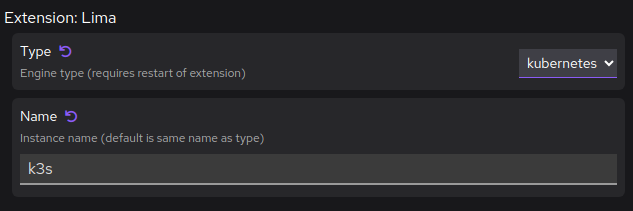Creating a Lima instance for Kubernetes workloads with Podman Desktop
To use the Lima provider you need a Lima instance running a Linux machine.
In the future, Podman Desktop might be able to create Lima instances.
Consider creating a custom Lima instance to:
- Control the assigned resources: CPUs, memory, and disk size.
- Control which Kubernetes distribution (
template) to install.
Prerequisites
Procedure
-
In a terminal, create the Lima instance.
-
To create a single-node Kubernetes cluster running k3s:
$ limactl start template://k3s -
To create a single-node Kubernetes cluster running k8s:
$ limactl start template://k8s -
To select the number of CPUs, the memory, and the disk size, add the options to the
limactl startcommand:--cpus=4 --memory=4 --disk=100
-
-
Wait for the instance to start, and restart the Lima extension.
-
Go to Settings > Preferences > Extension: Lima to change the instance name and type.
-
k3s
- Type: kubernetes
- Name: k3s

-
k8s
- Type: kubernetes
- Name: k8s

-
-
Go to Settings > Extensions > Lima to disable or enable the extension after changes.
-
Verification
-
When the installation is done, the location of the KUBECONFIG file is printed. See Configuring access to a Kubernetes cluster.
- Go to Settings > Preferences > Kubernetes to set the path of the file.
-
Use the
kubectl.limawrapper script to connect to the cluster:$ kubectl.lima version